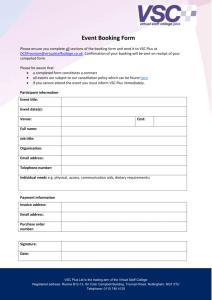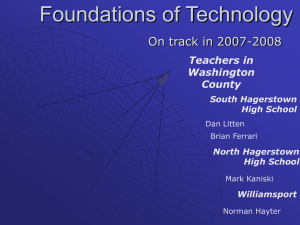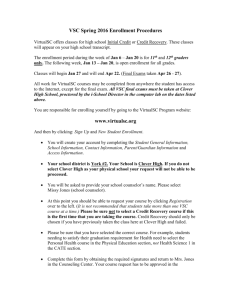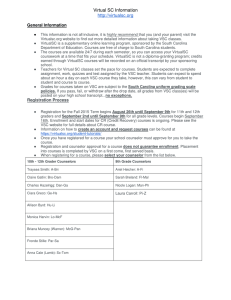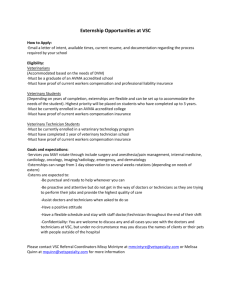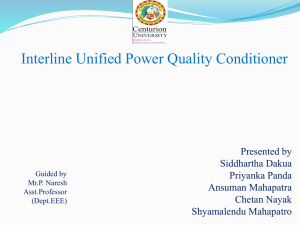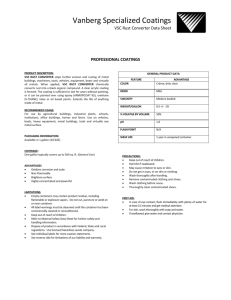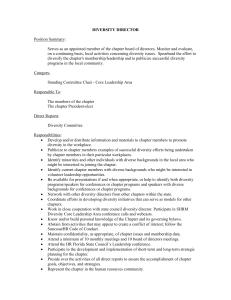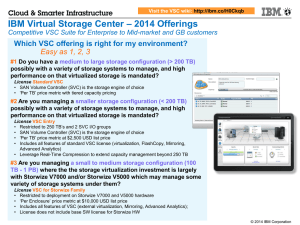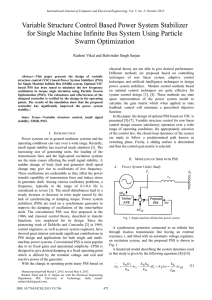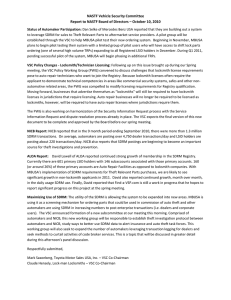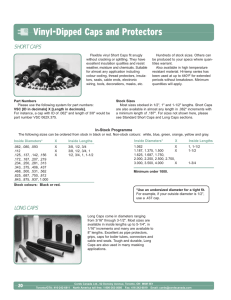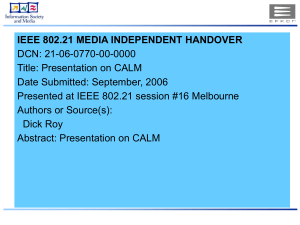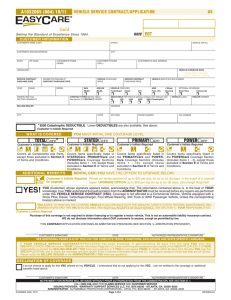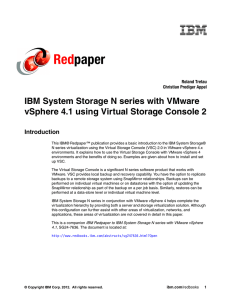virtual team - Society of Plastics Engineers
advertisement
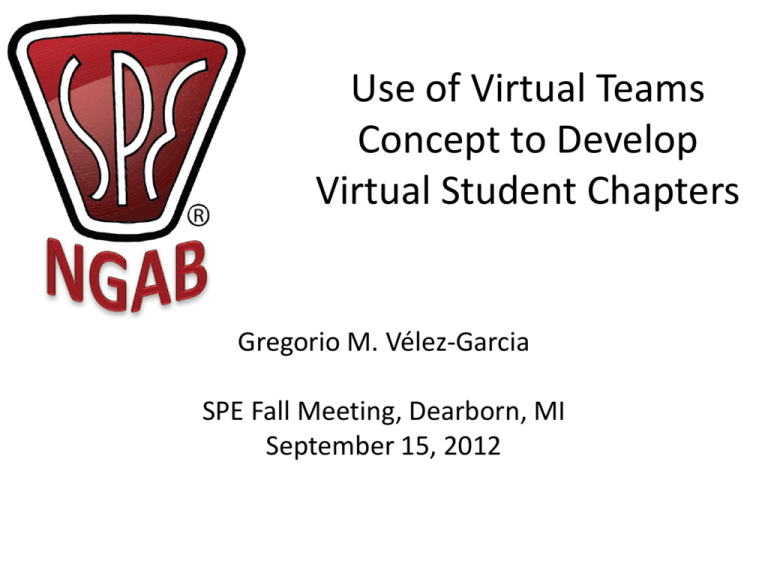
Use of Virtual Teams Concept to Develop Virtual Student Chapters Gregorio M. Vélez-Garcia SPE Fall Meeting, Dearborn, MI September 15, 2012 Next Generation Advisory Board • • • • • Chair: Vice Chair: EC Liaison: Staff Liaison: Members: Gregorio M. Vélez-García Jim Mason Dick Cameron Sue Wojnicki Paul Andersen, Jaime Gómez, Karen Hately, Adam Kramchuster, Dejin (Derek) Li, Kathy Perevosnik, and Sergio Sánchez. Goals for 2012-13 • Study and propose the use of Virtual student chapters. • Identify the needs of young professional members (YPM) at the early stages of their careers. – Propose a mentoring training program – Propose activities focused on YPM at ANTEC 2013 Agenda • What is a virtual team/virtual student chapter (VSC)? • How do we use VSC to increase membership? • Can we illustrate how they work, how successful and how popular they are? • What are the advantages/limitations of VSC? • What technical capabilities and resources are required? • Who will be the advisor? • Can we recommend rules or a manual for student chapters? • Include a time-line for the implementation? Virtual Student Chapter (VSC) • Definition of virtual team: – An interdependent group of individuals who predominantly use technology to communicate, collaborate, share information and coordinate their efforts in order to accomplish a common workrelated objective. Jones, F. S., Managing Virtual Work Teams Society for Human Resource Management. 2006 • Fact on virtual teams – In a virtual team, members are dispersed, either geographically or organizationally with their primary communications through electronic means (versus face-to-face). Team membership is also more likely to change over time than with traditional single-location teams . (ref: http://www.kulzick.com/virtteam.htm) • The concept of virtual team can be adapted to form virtual student chapters or virtual groups in the SPE. Virtual Team to increase membership • Development of a Virtual Student Chapter (VSC) as a pilot program in the SPE. – Reinforce the student participation and motivation – Provides opportunities to attract a number of students interested in plastics worldwide. • Virtual teams can attract young professional members who otherwise can’t participate. • A tool suitable for Divisions and some Sections. – Where frequent face to face meetings are not practical. Use of VSC in other professional societies • Pilot program – http://www.bpa.org/membership/virtualchapter • Example of virtual chapter – ASIS • http://www.asis.org/Chapters/chapters-student.html – National Association of Professional Organizers (NAPO) • http://napovirtualchapter.wordpress.com/about-us/meet-theboard/ – Society for Human Resources Management (SHRM) • http://www.shrm.org/Communities/SHRMChapters/StudentChapt ers/Pages/SHRMVirtualStudentChapters.aspx Advantages of virtual team/ VSC • Provides additional access to experts • Easier to attract and retain team members • Better accommodation to young members personal & professional lives • Dynamic team membership and content. • Allows assignment to multiple teams simultaneously • Provides faster response to market demands Ref: http://www.kulzick.com/virtteam.htm Limitations of virtual team/ VSC • Lack of physical interaction • Loss of face-to-face synergies • Possible lack of trust • Greater concern with predictability and reliability • Lack of social interaction Ref: http://www.kulzick.com/virtteam.htm Technical capabilities and resources required • Resources required: – document storage, group calendars and scheduling, collaboration and editing, teleconferencing, web conferencing, project site management, email and instant messaging. – See document: Tools for Global Virtual Teams • “The same that are used to provide online courses which is most colleges and universities in the world.” – SHRM • “A website, a meeting platform and good programming. We have variations of using a conference call line to doing webinars. Depends on the need of the speaker.” – NAPO VSC Advisor (virtual manager) • “There is no need for additional Student Advisors. The Advisor that handles traditional clubs and associations can enlist the officers to run the webpage and Facebook page along with the traditional activities the club or association does.” Steve Cates , SHRM • 3 tips on how to be a ‘Virtually Present’ leader – Choose the right technology – Have frequent ‘check-ins’ with your virtual team members – Create opportunities for social interaction Ref: http://virtualteamsblog.com VSC Rules • 5 tips to establishing a successful virtual team – Choose an experienced leader – Select members who are suited to working in virtual teams – Choose appropriate technology – Start with a face-to-face teambuilding – Understand the phases of a virtual team Ref: http://virtualteamsblog.com/2012/5-tips-to-establishing-a-successful-virtual-team/ • “There should be a section in your existing Student Handbook that addresses the unique areas for virtual clubs and associations. i would encourage you to keep these to a minimum. Your goal is to assimilate students...the fewer differences you can make between traditional and virtual the better....students are students....” Steven Cates, SHRM Phases to create a virtual team Phase What virtual managers should do… Forming Set clear expectations and ground rules, especially about the appropriate use of technology. Storming Establish guidelines and model appropriate behavior for resolving interpersonal conflicts. Norming Monitor virtual team processes and standards and adapt them as needed. Performing Make sure the team has the tools they need to perform their best. Adjourning Archive lessons learned and recognize team accomplishments. Ref: Chinowsky, P.S., Rojas, E.M. Virtual Teams: Guide to Successful Implementation. J. Management in Engineering (2003) Timeline for implementation • September 2012 – Present the idea of virtual student chapters during the fall meeting • October-December 2012 - Work with the OPC committee to establish a time line for memberfocus in Avectra as a platform for VSC – Forming and storming phase • Focus on identify the resources and logistic • Identify the faculty advisor • Identify targets in universities in US and overseas • January March 2013: Storming and norming phases – Write the pilot plan – Test capabilities with volunteer student groups • Fall 2013: Performing phase – Implement the first virtual student chapter Resources • Officers using virtual chapters – Steven Cates, Society for Human Resources Management – Amy Tokos, National Association of Professional Organizers Virtual Chapter • Useful websites – virtualteamsblog.com – www.kulzick.com/virtteam.htm – aroundthechaos.com/virtual-teams Resources • Publications – Tools for Global Virtual Teams – Ebrahim,NA, Ahmed, S, Taha, Z. Virtual Teams: a Literature Review. Aus tralian Journal of Bas ic and Applied Sciences (2009) – Katelyn Y. A. McKenna and Amie S. Green. Virtual Group Dynamics, Group Dynamics: Theory, Research, and Practice (2002). – Chinowsky, P.S., Rojas, E.M. Virtual Teams: Guide to Successful Implementation. J. Management in Engineering (2003) – Wilczynsky, V. and JENNINGS, JJ. Creating Virtual Teams for Engineering Design. Int. J. Engng Ed. Vol. 19, No. 2, pp. 316-327, 2003 – Warkentin, ME, Sayeed, L, Hightower, R. Virtual Teams versus Face-to-Face Teams: An Exploratory Study of a Web-based Conference System. Decision Sciences V28 Number 4, I997. Back up slides
